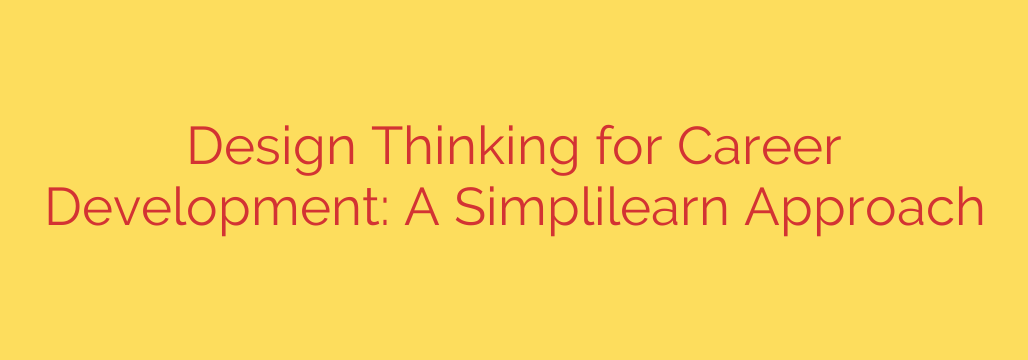
Reinvent Your Career Path: A 5-Step Guide to Using Design Thinking
Feeling stuck at a career crossroads? You’re not alone. The traditional idea of a rigid, linear five-year plan often fails to account for a rapidly changing job market and our own evolving passions. If you’re looking for a more dynamic, flexible, and human-centered way to navigate your professional life, it’s time to think like a designer.
Design thinking is a powerful problem-solving framework used by innovators to create groundbreaking products and services. Its core principle is simple: start with human needs. By applying this same iterative and empathetic process to your own career, you can move from uncertainty to clarity and build a professional life that is both successful and deeply fulfilling.
Here’s how to use the five stages of design thinking to architect your ideal career.
Step 1: Empathize – Look Inward and Outward
Before you can solve a problem, you must first understand it completely. In product design, this means understanding the end-user. In career design, the primary user is you. The empathy stage is about deep self-reflection and market observation.
Start by conducting a personal audit. Ask yourself critical questions:
- What activities at work give me energy? Which ones drain me?
- What are my core values (e.g., financial security, autonomy, creativity, social impact)?
- What skills do I enjoy using the most?
- What problems in the world am I passionate about solving?
Next, turn your focus outward. Understand the needs of the job market. Research industries and roles that align with your self-assessment. Talk to people in those fields. What are their daily challenges? What skills are in high demand? This dual focus on your internal needs and external realities is the foundation of a well-designed career.
Step 2: Define – Pinpoint Your Career Challenge
With the insights gathered from the empathy stage, you can now clearly define the problem you’re trying to solve. A vague goal like “I need a new job” is too broad to be actionable. A well-defined problem statement is specific and frames the challenge in a positive, forward-looking way.
For example, instead of “I’m bored at my current job,” a better definition would be:
- “How can I find a role that leverages my data analysis skills for a mission-driven organization?”
- “How might I transition from a large corporate environment to a startup culture to have a greater impact?”
A clear, well-framed problem statement acts as your compass, guiding your brainstorming and ensuring you’re solving the right challenge. It transforms a complaint into a concrete and solvable design quest.
Step 3: Ideate – Brainstorm Your Future Possibilities
This is the creative, no-limits phase of the process. With your defined problem statement in mind, your goal is to generate as many potential career paths and solutions as possible. During this stage, focus on quantity over quality. Don’t filter or judge your ideas—just get them all out.
Try these ideation techniques:
- Mind Mapping: Start with your problem statement in the center and branch out with different roles, industries, companies, and skills.
- Three Alternate Paths: Sketch out three completely different five-year scenarios. For example, one path could be doubling down on your current career, a second could be a total industry pivot, and a third could involve starting a side business.
- Crazy Eights: Quickly sketch eight different ideas in eight minutes. The time pressure forces you to move past the obvious answers.
The result of this stage shouldn’t be a single perfect answer, but a rich list of diverse and interesting possibilities to explore.
Step 4: Prototype – Test Your Ideas on a Small Scale
You wouldn’t build an entire factory without first testing the machinery. Similarly, you shouldn’t commit to a massive career change without first testing your assumptions. Prototyping is about creating low-cost, low-risk experiments to get real-world experience with your top ideas.
Career prototyping is the most critical step for avoiding a costly misstep. It’s how you gather data about what a potential career is really like.
Actionable prototypes include:
- Conducting Informational Interviews: Don’t ask for a job. Instead, ask people in your target role or industry about their experience. This is a prototype for a conversation.
- Taking on a Freelance Project: Use a platform like Upwork or Fiverr to complete a small project related to a new skill or industry you’re considering.
- Enrolling in a Short Online Course: Test your interest in a new field (like coding, digital marketing, or UX design) with a short-term, low-cost course before committing to an expensive degree.
- Volunteering: Offer your skills to a non-profit to gain experience in a new area and see if you enjoy the work.
Step 5: Test – Gather Feedback and Refine Your Approach
The final stage is to test your prototypes and learn from them. After completing a prototype, analyze the experience. Did you enjoy the freelance project? What did you learn from your informational interviews? Did the online course spark your curiosity or reveal a lack of passion?
The feedback you gather is invaluable. It will either validate your interest in a particular path or give you the crucial insight to pivot without having made a major commitment. This process is a cycle, not a straight line. The results of your tests will likely lead you back to the ideation or prototyping phase with new knowledge and a refined perspective.
By embracing this iterative loop of empathizing, defining, ideating, prototyping, and testing, you remove the pressure of having to find one perfect answer. Instead, you empower yourself to explore, learn, and adapt, building a career that is resilient, rewarding, and uniquely yours.
Source: https://www.simplilearn.com/design-thinking-principles-for-career-development-article








